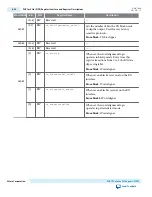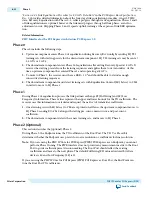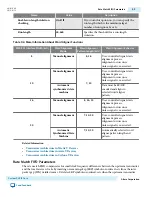
The tuning sequence typically includes the following steps:
1. The Endpoint receives the starting presets from the Phase 2 training sets sent by the Root Port.
2. The circuitry in the Endpoint receiver determines the BER and calculates the next set of transmitter
coefficients using FS and LF and embeds this information in the Training Sets for the Link Partner to
apply to its transmitter.
The Root Port decodes these coefficients and presets, performs legality checks for the three transmitter
coefficient rules and applies the settings to its transmitter and also sends them in the Training Sets.
Three rules for transmitter coefficients are:
a. |C
-1
| <= Floor (FS/4)
b. |C
-1
|+C
0
+|C
+1
| = FS
c. C
0
-|C
-1
|-|C
+1
|>= LF
Where:
C
0
is the main cursor (boost)
C
-1
is the pre-cursor (pre shoot)
C
+1
is the post-cursor (de emphasis)
3. This process is repeated until the downstream component's receiver achieves a BER of < 10
-12
.
Phase 3 (Optional)
This section describes the (optional) Phase 3.
During this phase, the Root Port tunes the Endpoint’s transmitter. This process is analogous to Phase 2
but operates in the opposite direction.
Note: If you are using the PHY IP Core for PCI Express (PIPE) PCI Express as a Root Port, you cannot
perform Phase 3 tuning.
Once Phase 3 tuning is complete, the Root Port moves to Recovery.RcvrLock, sending EC=2’b00, along
with the final coefficients or preset agreed upon in Phase 2. The Endpoint moves to Recovery.RcvrLock
using the final coefficients or preset agreed upon in Phase 3.
Recommendations for Tuning Link Partner’s Transmitter
This section describes tuning link partner’s transmitter.
To improve the BER of the StratixV receiver, Altera recommends that you turn on Adaptive Equalization
(AEQ) one-time mode during Phase 2 Equalization for Endpoints or Phase 3 Equalization for Root Ports.
You enable AEQ through the Transceiver Reconfiguration Controller IP Core. For more information
about this component, refer to Transceiver Reconfiguration Controller IP Core. For more information
about running AEQ, refer to AEQ Registers.
Note: AEQ must be turned off while switching from Gen3 to Gen1 or from Gen3 to Gen2.
Enabling Dynamic PMA Tuning for PCIe Gen3
“Section 4.2.3 Link Equalization Procedure for 8.0 GT/s Data Rate” in the PCI Express Base Specification,
Rev. 3.0 provides detailed information about the four-stage link equalization procedure. However, in
UG-01080
2015.01.19
Phase 3 (Optional)
8-23
PHY IP Core for PCI Express (PIPE)
Altera Corporation
Send Feedback
















































